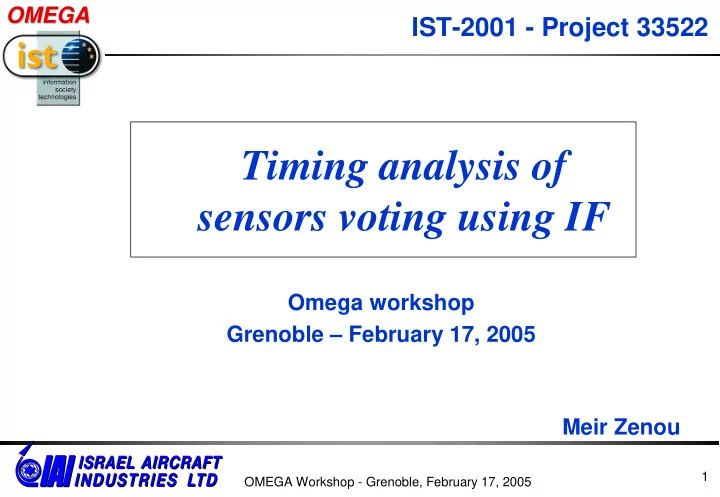

OMEGA OMEGA IST-2001 - Project 33522 IST-2001-33522 Timing analysis of sensors voting using IF Omega workshop Grenoble – February 17, 2005 Meir Zenou 1 OMEGA Workshop - Grenoble, February 17, 2005
OMEGA OMEGA System overview IST-2001-33522 Sensor A (#1) Sensor A (#2) Sensor A (#3) � Flight Control Flight Control Flight Control Computer (#1) Computer (#2) Computer (#3) Servo-Actuator 2 OMEGA Workshop - Grenoble, February 17, 2005
OMEGA OMEGA Voting & Monitoring IST-2001-33522 � Voting : � From the three received Sensor or Command (Channel) values , detect if one of them is "out of range" ( e.g : largely different from the others ) � Monitoring : � If a sensor/channel is detected discrepant for more than N successive cycles,this channel is disqualified . Also , if a channel is correct for more than N cycles , it is qualified � If a sensor/channel is detected discrepant for more than N' cycles ( not successive ) , a warning is generated � Results are provided to System Health Manager 3 OMEGA Workshop - Grenoble, February 17, 2005
OMEGA OMEGA System overview (3) IST-2001-33522 Sensor1 Sensor2 Sensor3 1 1 VotingAndMonitoring::DevMe 1 1 Health System RTC 1 1 1 ChannelRight ChannelLeft FC 4 OMEGA Workshop - Grenoble, February 17, 2005
OMEGA OMEGA Tools evaluation IST-2001-33522 Tools Case study Activities Play Engine One CPU and 3 sensors GUI , Behavior specification , Behavior verification RUVE Focus on non-realtime issues Drive to state & Drive to Property (direct Reduced Model ( 12 classes , and negative) 4 statecharts) IF No functionality (voting , Mainly Verification of timed monitoring , computations..) properties All objects are active Two CPUs. 5 OMEGA Workshop - Grenoble, February 17, 2005
OMEGA OMEGA Time requirements IST-2001-33522 � Sensor Time specifications � Acquiring of physical measurement requires 0.5 to 3 msec � Treatment and transfer to Muxbus requires 0.1 to 0.5 msec � Muxbus Time specifications � Writing data from Sensor to its memory requires 100 to 200 usec � Reading data from its memory and provision to CPU requires 50 to 100 usec 6 OMEGA Workshop - Grenoble, February 17, 2005
OMEGA OMEGA Class diagram IST-2001-33522 7 OMEGA Workshop - Grenoble, February 17, 2005
OMEGA OMEGA Sensor IST-2001-33522 8 OMEGA Workshop - Grenoble, February 17, 2005
OMEGA OMEGA Muxbus IST-2001-33522 9 OMEGA Workshop - Grenoble, February 17, 2005
OMEGA OMEGA System IST-2001-33522 10 OMEGA Workshop - Grenoble, February 17, 2005
OMEGA OMEGA IF observer : Sampling time limits IST-2001-33522 Express the minimal and maximal delays authorized to the System till it � enters the compute state : Minimal delay (msec) : Min(acquiring) + Min(treatment ) + 3 X Min(muxbus � Write) + 3 X Min ( muxbus Read ) = 500 + 100 + 3x100 + 3x50 = 1050 Maximal delay (msec) : Max(acquiring) + Max(treatment ) + 3 X Max(muxbus � Write) + 3 X Max ( muxbus Read ) = 3000 + 500 + 3x200 + 3x100 = 4400 11 OMEGA Workshop - Grenoble, February 17, 2005
OMEGA OMEGA IF observer : Sampling time limits IST-2001-33522 12 OMEGA Workshop - Grenoble, February 17, 2005
OMEGA OMEGA IF observer : Entering error state IST-2001-33522 Express that if the system was in error state , at most one sensor was OK � This is obtained by counting the generations of evWrite events ( expressing � that the sensor is OK ) and checking the counter value when the system has entered the error state 13 OMEGA Workshop - Grenoble, February 17, 2005
OMEGA OMEGA IF observer : Entering error state IST-2001-33522 14 OMEGA Workshop - Grenoble, February 17, 2005
OMEGA OMEGA IF observer : Time difference IST-2001-33522 Evaluate ( t timer ) the time delay between the read of the same sensor � from Muxbus memory by two different Nodes and check that this delay does not exceed an expected limit . The time limit corresponds to the following worst sequence � Sensor writes Data 1 � Node 1 reads Data 1 � 100 Sensor writes Data 2 � 200 Sensor writes Data 3 � 200 Node 2 reads Data 1 � We checked the model with 2 values for the timeout : With 500 it is OK � while with 501 usec we reach error state 15 OMEGA Workshop - Grenoble, February 17, 2005
OMEGA OMEGA IF Observer : Time difference IST-2001-33522 16 OMEGA Workshop - Grenoble, February 17, 2005
OMEGA OMEGA Conclusions IST-2001-33522 Strong capability of time analysis and model checking Can serve for Model debugging – simulation . User friendly Observers statecharts Observers statecharts multiplication can complicate the model. Cryptic error messages Scalability problem 17 OMEGA Workshop - Grenoble, February 17, 2005
Recommend
More recommend